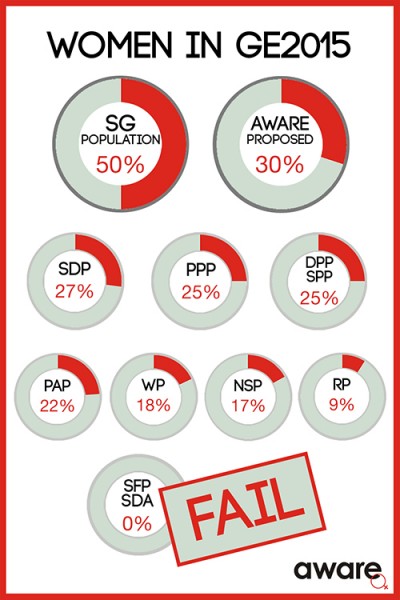On 7 November, AWARE hosted the Big Birthday Ball – its fifth and biggest ever fundraising gala. 500 guests came together at the Shangri-La Hotel to celebrate AWARE’s 30th birthday, and to support its work assisting women in crisis and promoting gender equality.
This stellar evening of food and entertainment was hosted by Cultural Medallion winner Ivan Heng and actor/director Oon Shu An. Popular parody troupe Chestnuts and Singapore’s favourite a cappella group Vocaluptuous joined them on stage.

Photo by: Jacqueline Choo | Invertigo Studios
The Big Birthday Ball has raised a total of $357,000 for AWARE’s work in gender equality, of which $117,000 will go to #asinglelove, AWARE’s new collaboration to stand up for single parents.
Together with Daughters of Tomorrow and Kinetic, #asinglelove will nurture a strong peer support network of at least 100 mothers, offering mutual assistance and access to services, skills training, employment mentoring and more. An accompanying high-profile communications campaign will promote inclusion and equality for single parents.

Photo by: Jacqueline Choo | Invertigo Studios
The evening also saw the crowning of the AWARE and Alamak! Award winners for 2015. The AWARE Awards recognise individuals and organisations that promote gender equality in Singapore. There are three AWARE Award winners this year:
- Aidha received the Financial Empowerment – NGO Award.
- Citi received the Financial Empowerment – Corporate Initiative Award.
- Student group, The G Spot, received the Student Initiative Award.
Do scroll down for further details on the winners!
The popular Alamak! Award, ‘honouring’ the public’s favourite sexists, was also announced. After six weeks of online polling, the anti-mother sexists of GE2015 have pulled 78% of the total votes, as the public rallied together to give them a unified Alamak!
This collective nomination included NSP’s Cheo Chai Chen, who called Tin Pei Ling’s new mother status a ‘weakness’, Mothership’s Belmont Tay who derided Kevryn Lim’s modelling photos as ‘unmotherly’, PAP’s Lim Boon Heng’s suggestion that women ‘put mother-child relationships at risk’ when they stand for elections, and TODAY’s headlines labelling SDP’s Jaslyn Go as ‘mother-of-two’ while male candidates were introduced by profession.
Click here to see more photos of this spectacular event.
AWARE Awards 2015 receipients
Financial Empowerment: NGO – Aidha
 Foreign domestic workers have a marginalised status in Singapore – labour laws don’t adequately protect them, and many women don’t get their day off every week. Sometimes they are tied to abusive employers due to their financial circumstances.
Foreign domestic workers have a marginalised status in Singapore – labour laws don’t adequately protect them, and many women don’t get their day off every week. Sometimes they are tied to abusive employers due to their financial circumstances.
Aidha seeks to help them escape the cycle of poverty with financial empowerment courses that impart skills such as financial and computer literacy, as well as entrepreneurship and business management.
Aidha has taught over 2,700 women since 2006 – 714 in 2014 alone. In 2015, they aim to take in 1,000 new students. For many students, Aidha’s courses are a rare chance to develop not only financial skills, but also self-confidence, as well allowing them to enjoy a sense of community. The skills they learn enable them to manage their own finances and break out of poverty by developing and meeting savings goals and achieving long-term financial plans. Over 70% of Aidha’s students succeed in either opening small businesses of their own or making investments in productive assets, such as land and livestock.
Financial Empowerment: Corporate Initiative – Citi
 As Singapore’s population ages, it becomes more urgent than ever to meet the needs of older people. Lower-income older women are one of the most financially vulnerable segments in Singapore. These women are often caregivers of both their children and aged parents, and their financial priorities may lie within their family rather than themselves. As a result, they may run into financial problems later in their silver years, due to a lack of savings for themselves and their longer life expectancy.
As Singapore’s population ages, it becomes more urgent than ever to meet the needs of older people. Lower-income older women are one of the most financially vulnerable segments in Singapore. These women are often caregivers of both their children and aged parents, and their financial priorities may lie within their family rather than themselves. As a result, they may run into financial problems later in their silver years, due to a lack of savings for themselves and their longer life expectancy.
Tsao Foundation brought these findings to Citi, and they collaborated to develop a long-term strategy and vision for large-scale and sustainable financial literacy education. Citi drew on its in-house expertise to inform the curriculum, and offered financial and material support to raise funds and awareness to ensure the successful launch of the programme in 2008.
The Citi-Tsao Foundation Financial Education Programme for Mature Women has built capabilities for numerous lower-income women aged 40-60 to understand their roles and relationship dynamics within their families, and has equipped them with basic financial knowledge and skills to work towards retirement adequacy. Since 2008, the programme has reached over 6,000 women. In 2012, People’s Association Women’s Integration Network (PA WIN) adopted the programme with the target to offer the programme at every community centre in Singapore. The programme is available in English, Malay and Mandarin, and has been replicated in Indonesia and Malaysia.
In 2013, an impact assessment from a study of 1,360 participants who completed the programme from August 2008 to August 2012 concluded that the programme has been effective in improving the lives of the mature women through higher financial literacy and positive financial behaviour change.
- % who started a financial plan for retirement after programme : 50.4%
- % who are more knowledgeable of financial products that suit their needs: 49.3%
- % who felt more empowered on money matters: 46.5%
- % who started building their emergency fund at end of course: 32.8%
Student activism – The G Spot
 While many others spend their university days studying or socialising, the students behind The G Spot work hard to advocate gender equality and LGBT inclusion on campus. Founded in 2013, The G Spot adopts an intersectional approach, recognising the links between different forms of discrimination, and how attitudes to gender and sexuality are closely related.
While many others spend their university days studying or socialising, the students behind The G Spot work hard to advocate gender equality and LGBT inclusion on campus. Founded in 2013, The G Spot adopts an intersectional approach, recognising the links between different forms of discrimination, and how attitudes to gender and sexuality are closely related.
The G Spot has organised innumerable events on gender equality and LGBT inclusion, reaching hundreds of students and members of the public, often in collaboration with and support of NGOs and other student organisations. From intimate sharing sessions to large expert panel discussions, some notable events include an interfaith discussion on sexuality, visual arts workshops for migrant domestic workers, and a successful fundraiser for a shelter for transgender people in crisis.
The G Spot has led the way in on-campus student activism and organising for student peer support and resources. With the student government, they made newspaper headlines by successfully lobbying for gender-neutral accommodation on the Yale-NUS campus, sparking national discussions on gender, youth and sexuality.
After successfully making waves not only on campus, but also in the public eye at only two years old, we are excited to see what kind of activism The G Spot will nurture in the years to come.




 By Teo You Yenn, Board member
By Teo You Yenn, Board member By Goh Li Sian, Research and Advocacy Coordinator
By Goh Li Sian, Research and Advocacy Coordinator Where does the haze come from? How does haze affect other, pre-existing inequalities in South-East Asia and beyond? Most importantly, what can we do?
Where does the haze come from? How does haze affect other, pre-existing inequalities in South-East Asia and beyond? Most importantly, what can we do?
 Notoriously, Cheo Chai Chen called rival Tin Pei Ling’s new mother status a “
Notoriously, Cheo Chai Chen called rival Tin Pei Ling’s new mother status a “
 Fathers? What are those?
Fathers? What are those? 

